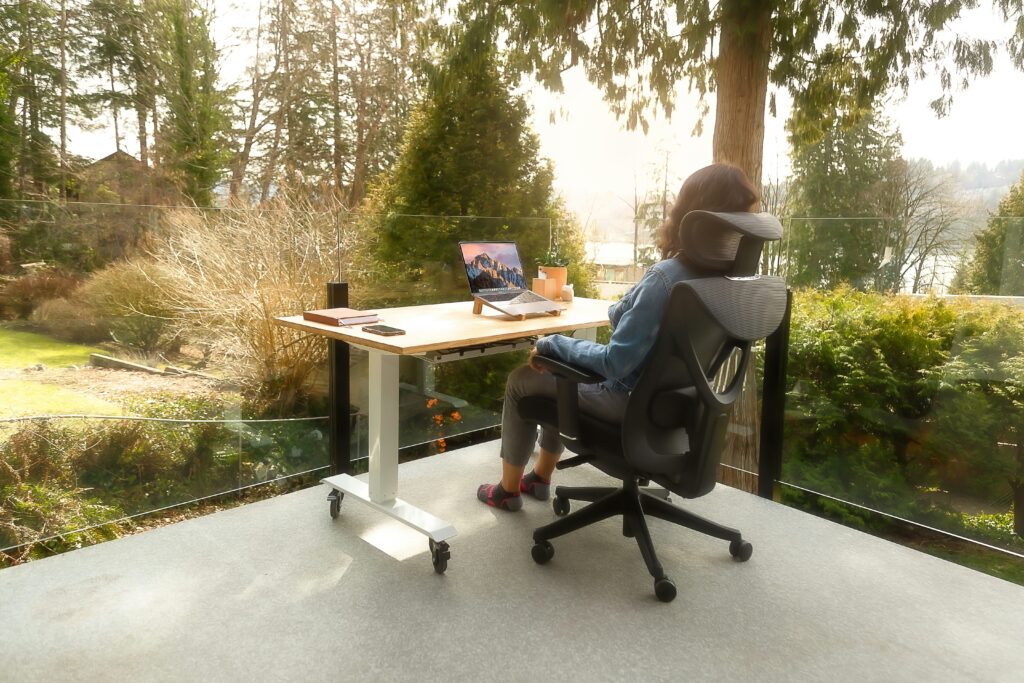Working from home is convenient—but it can take a toll on your body. One of the most common questions is: “Should I sit or stand while working?”
The truth: Both sitting and standing have benefits and drawbacks. This guide will help you understand how each affects your body and how to set up a workspace that keeps you healthy and productive.
Why Sitting Too Much is a Problem
Sitting for long hours is often called the “new smoking.” Research links prolonged sitting to:
- Back and neck pain due to poor posture
- Weight gain from low calorie burn
- Heart disease and diabetes risks
- Poor circulation, swelling, and stiffness
Even regular exercise can’t fully undo the effects of sitting all day.
The Pros of Sitting Desks
Sitting desks aren’t bad—they’re essential when used correctly.
Benefits include:
- Posture support: Ergonomic chairs with lumbar support keep your spine aligned.
- Focus and comfort: Stable keyboard and mouse positioning helps with long typing sessions.
- Accessibility: Cheaper and easier to set up in small spaces.
- Storage options: Traditional desks often include drawers and shelves for organization.
Tip: Proper chair and desk height are key to avoiding pain.
The Benefits of Standing Desks
Standing desks are popular for reducing sitting-related health risks.
Advantages:
- Burn more calories than sitting
- Reduce risk of chronic diseases with better circulation
- Improve posture by engaging core muscles
- Boost energy and focus for some users
Potential drawbacks:
- Leg and foot fatigue if standing too long
- Possible worsening of varicose veins
- Higher cost for adjustable models
Ergonomics: How to Set Up Your Desk
Sitting Desk Setup
- Chair: Adjustable height, lumbar support, armrests at desk level
- Desk: Elbows at ~90° while typing
- Monitor: Top of screen at eye level, 20–30 inches from face
- Feet: Flat on the floor or on a footrest
Standing Desk Setup
- Desk height: Elbows at ~90°, shoulders relaxed
- Monitor: Top of screen at eye level
- Footwear: Comfortable shoes or anti-fatigue mat
- Movement: Shift weight or take micro-breaks every 30–60 minutes
The Hybrid Approach: Sit-Stand Routine
Switching between sitting and standing often provides the best balance for comfort and productivity.
Tips for an effective sit-stand routine:
- Start small: 15–30 minutes of standing per hour
- Use timers or apps for reminders
- Move and stretch regularly
- Listen to your body—don’t overdo it
Special Considerations
- Lower back pain: Alternate positions to reduce strain
- Circulation: Standing with micro-movements improves blood flow
- Footwear & flooring: Anti-fatigue mats prevent leg strain
- Pregnancy or joint issues: Sit-stand desks are safer than standing all day
Productivity: Sitting vs. Standing
- Sitting: Best for typing-intensive tasks and detailed work
- Standing: Ideal for calls, brainstorming, or light tasks
- Hybrid approach: Alternating positions can boost alertness and focus
Choosing the Right Desk
Factors to consider:
- Budget: Adjustable desks cost more but offer flexibility
- Space: Consider footprint and cable management
- Adjustability: Height-adjustable desks suit multiple users
- Stability & material: Look for solid frames and smooth mechanisms
Popular Options:
- Fixed-height sitting desks
- Manual crank standing desks
- Electric sit-stand desks
Must-Have Accessories
- Anti-fatigue mats (for standing)
- Footrests (for sitting)
- Monitor arms for correct screen height
- Ergonomic chairs with lumbar support
- Cable management tools
Final Verdict
There’s no one-size-fits-all solution.
- Alternate between sitting and standing for optimal health
- Follow ergonomic principles for desk, monitor, and chair setup
- Use accessories to reduce strain
- Adjust gradually, and prioritize comfort
Key Takeaways:
- Prolonged sitting has health risks; standing desks help but aren’t a complete solution
- Ergonomics are more important than desk type
- Alternating positions improves comfort, focus, and circulation
- Small adjustments make a big difference over time


